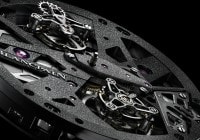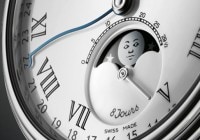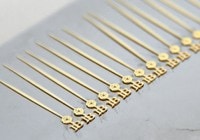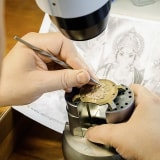
Search in Issues
Chapters
List of parts
Chapter 6
HANDS
Delicate, diverse and demandingly precise.
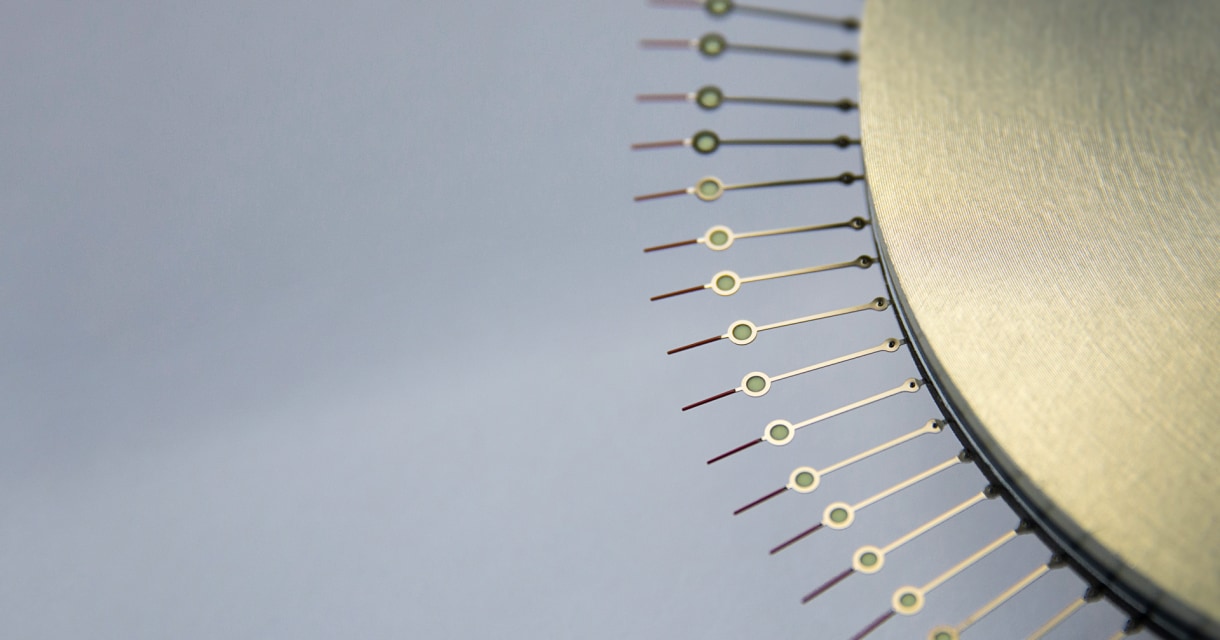
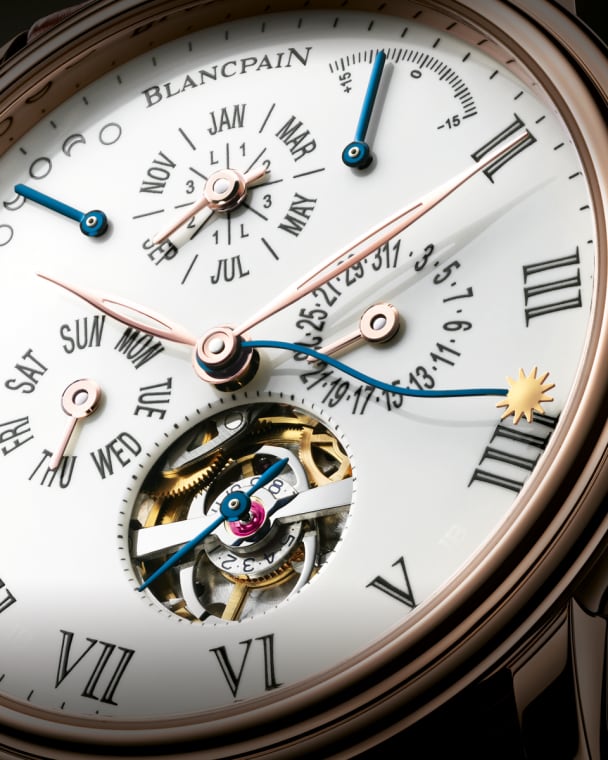
A single watch, the Villeret Équation du Temps Marchante with five distinct hand styles.
The production of hands is one of WATCHMAKING’S GRAND SPECIALTIES.
As a connoisseur of fine timepieces, have you ever inspected watch hands? Inspected...really inspected? Beyond gazing. Beyond looking. Instead, preferably armed with a loop, doing a deep dive to extract every fine detail of form and finishing. If you take the plunge, either during your submersion or afterwards when you once again regain the surface, several thoughts no doubt will plant themselves in your consciousness. First the insight, “even a seemingly simple straight hand is actually not so simple after all, as it, with study, reveals subtly complex forms and details”, likely swiftly followed by the question, “just how can these impossibly small, complex, and delicate objects ever be made?” It was precisely that immersion and subsequent surfacing that lay behind a trip to Universo in La Chaux-de-Fonds to learn the secrets behind the multitude of Blancpain hand styles.
It probably is no surprise to learn that the production of hands is one of watchmaking’s grand specialties. The historical roots of this craft led to a proliferation of very small workshops dispersed throughout Switzerland, each one serving the particular needs of the watch workshops located nearby. Today’s Universo, a member of the same group as Blancpain and the source of all of Blancpain’s hands, was formed more than a century ago from the merger of no less than fifteen such small workshops. Over time, yet further consolidation took place with eight more small ateliers joining in 1924. By the 1940s, forty miniature manufacturing sites had merged in or been closed in the process of consolidation. By 1949, which saw the opening of a new atelier in Vallorbe (just outside of the Vallée de Joux), Universo had coalesced into twelve different, geographically dispersed production sites. Thus, although legally unified and, from the point of view of administration and finance consolidated, in practice these were all nearly independent workshops operating separately from one another. In one important sense, this nearly autonomous way of operating in dispersed shops reflected the historical artisanal roots of this craft aimed at meeting the unique demands from each watch manufacturer to have its own distinct hand styles. Just as one surveying the universe of watches can’t help but remark upon this enormous diversity of hands, not only in style but in quality as well, operating separately well served the purpose of permitting that diversity to flourish.
The demand for DIVERSE STYLES is greater today than ever before.
Certainly, not only does the demand for diverse styles continue, if anything it is greater today than ever before. In Blancpain’s case, six different collections, each with its own signature style, are offered. Then, recall that that when modern Blancpain emerged in the 1980s there was but one single collection with but one style. However, the range is far broader than suggested by the number of collections, as within a single collection, there can be wide design differences. For example, within the Fifty Fathoms collection, the hands of the Bathyscaphe models have their own separate identity distinct from core Fifty Fathoms models. Even then, within the Bathyscaphe subcollection there are some remarkable distinctions between the hands for the ceramic case models and those for the steel. And carrying matters further, a single watch may incorporate a variety of different shapes and colors such as the Villeret Quantième Perpétuel 8 Jours with leaf hour and minute hands, blue small counter hands, and small contrasting counter hands. So although today Universo may have succeeded in conquering its dispersion of small workshops, bringing the manufacture under one roof, it has done so in a way to perpetuate its origins in being able to respond the requirements for a multitude of radically disparate shapes and styles. What this means is that Universo within its walls is home to a vast range of methods and processes which it calls upon depending upon the design of each particular hand.
Banish all thought that a day spent in La Chaux-de-Fonds yielded the secret process or recipe to make the hands for Blancpain. It’s that diversity at work again, because for even a single watch, much less those found in different collections, a full repertoire of processes are brought to bear, varying according to the specifics of each hand.
A few basics to understand hand making fundamentals. Most watch hands are constructed as a single
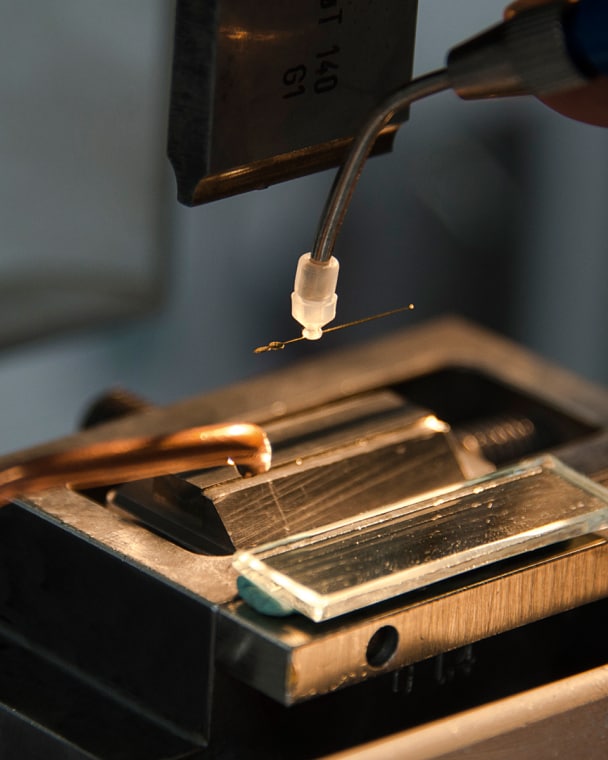
The shaping of hands with a stamping tool.
Hand fabricators must MASTER A MULTITUDE OF TECHNIQUES.
piece referred to as a planche (plate). The planche can be thought of as being comprised of two principal elements: the tête (head) which includes a small hole outfitted with a canon (small grip) which attaches the hand solidly to the axis supporting it in the watch and the corps (body) which is its arm ending in the point. Some hands such as large seconds or chronograph seconds have a more complicated form as they incorporate a counterweight placed opposite the corps.
For the hour and minute hands, fabrication begins with the hole and the canon. According to the length of the hand, specifications and tolerances are defined for its later attachment to its axis. Proper attachment will depend upon the precision of the hole and canon created through the stamping of the planche.
For other hands that require a deeper canon, the hole is hand drilled and the canon, thereafter, hand riveted in place. Deeper canons are particularly essential for long hands that move rapidly such as large seconds or chronograph seconds (and as connoisseurs know, the return to zero of a chronograph seconds hand is particularly rapid, bordering on violent and, thus, requires an extra robust attachment design). The extra deep canon helps ensure that a hand so equipped will stay securely attached to its axis. The demands for precision in this process are enormous. Blancpain’s tolerance is on the order of one micron!
The fabricators of watch hands have a choice of different methods for creating the planche. For the Villeret hour and minute hands a cutting process is used. These hands feature a squelette (skeleton) center which also is achieved in the cutting process. An initial polishing, artisanal in its application, follows the cutting. A specialist glues the hands to a holder and, respecting grand watchmaking tradition, polishes each hand, one by one. Thereafter, the hands are washed and given a detailed visual examination. Following this inspection, the hour hands are given a gentle stamping in order to create a decorative filet effect. This is a sloping downward angle applied to the outer edge of the tête. As well, through stamping, anunderstated rounding is applied to the corps. The minute hands receive an additional decoration which is called gouge. The gouge consists of a refined groove around the center of the tête. The gouge decoration brings added visual interest to the center. The hour hand, by contrast, is not given gouge decoration. A few moments of thought lead to the reason why. Since the tête of the minute hand completely covers that of the hour hand, any gouge decoration on the hour hand would not be visible!
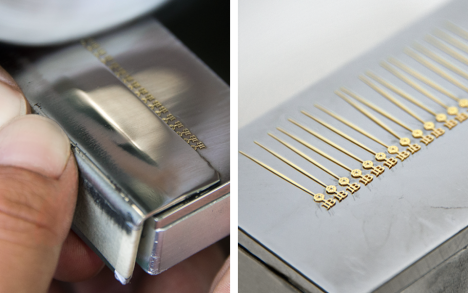
Fine polishing.
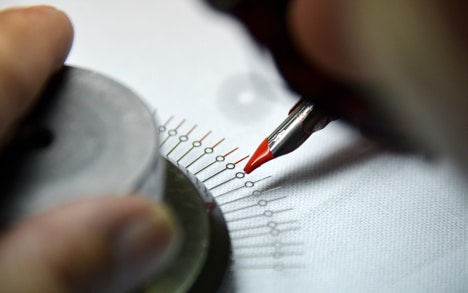
Hand painting of the tip.
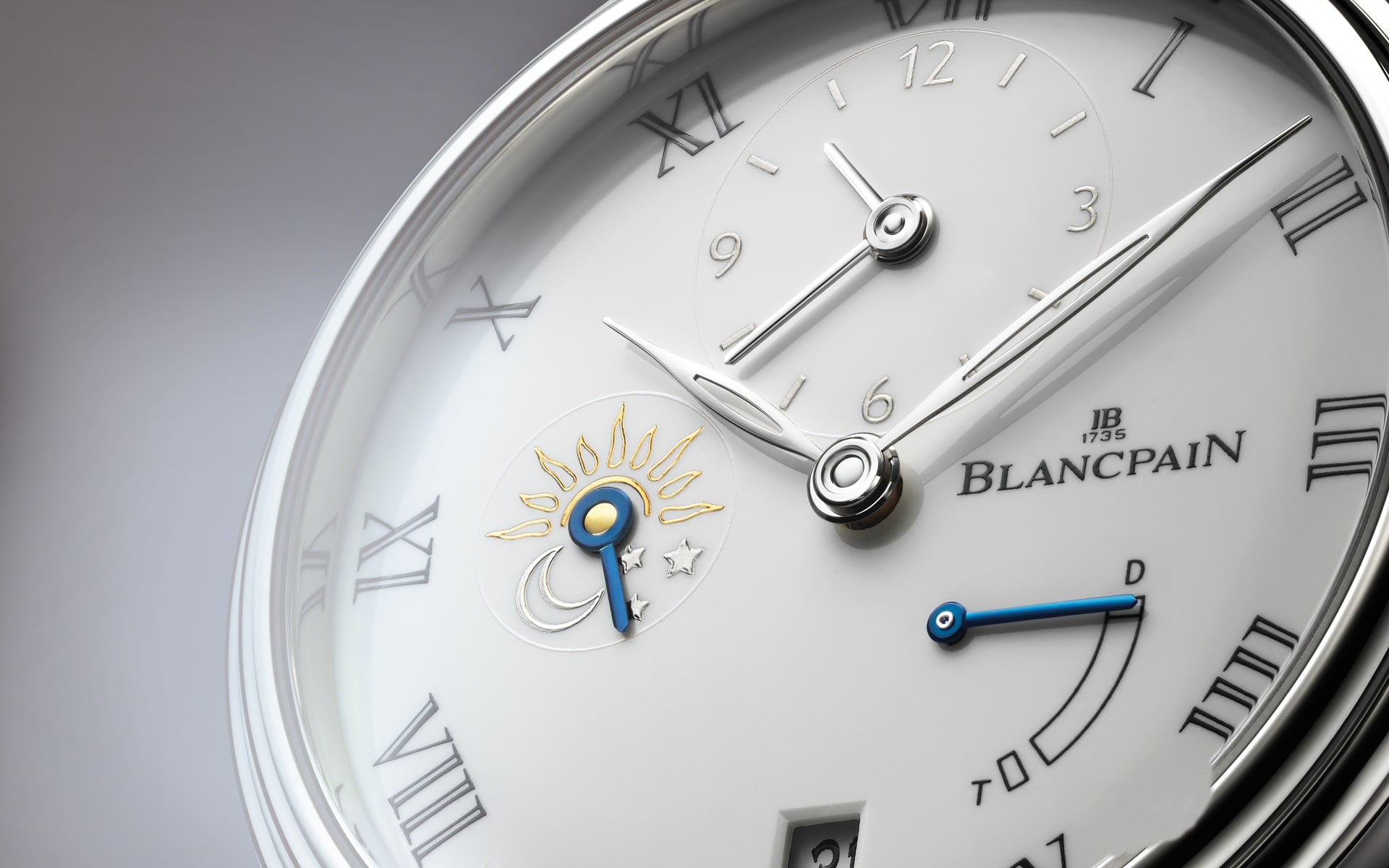
Watchmaking TRADITION is respected in the crafting of blued hands.
Still more steps remain. A second polishing is performed on each hand, one by one, to achieve a brilliant finish. That is followed by cleaning and another careful visual inspection. Since the Blancpain Villeret hands have been subtly rounded, this inspection must include an examination to verify that the curvature of the corps is correct and that the tête remains perfectly flat.
Depending on the complication there are additional processes. For example, the Villeret Quantième Perpétuel 8 Jours features blued hands for the month, day of the week and date indications. Although many in the watch world use chemicals or a galvanic process in order to arrive at a blue color, Blancpain respects watchmaking tradition which demands a heat process to produce the blue. There is enormous savoir-faire required to achieve a perfect blue color which is not only uniform along the entirety of the hand but between different hands on the same watch. Following the bluing process, each hand undergoes a detailed visual inspection to verify the uniformity of color, flatness, and shape.
Things become more complicated still for Blancpain’s blued serpentine hands. These hands are found on the Villeret complete calendar/moon phase timepieces.
The presence of these serpentine hands used for the date indication honors a grand historic watchmaking tradition. In the past, watchmakers employed serpentine hands for supplementary indications such as the date, the serpentine shape serving to distinguish the supplemental indication from the principal time indications. As Blancpain’s serpentine hands are blue in color, they undergo the same heat bluing process as the straight blue counter hands. Following bluing, each hand is individually inspected for flatness and shape using a loop.
There is yet an additional inspection process for long thin hands such as those used for a chronograph. These hands are placed on the flat plate called a plaque à rectifier to ensure perfect flatness. If necessary, a hand may receive a delicate manual straightening.
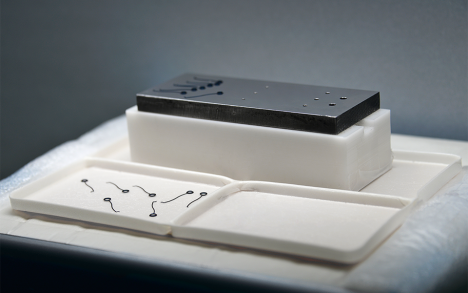
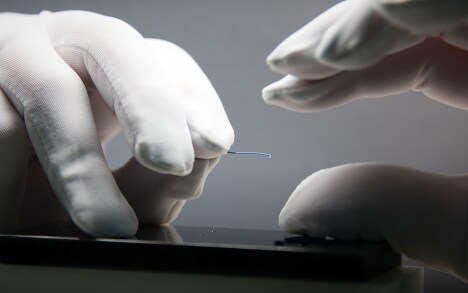
Verifying and correcting flatness for each individual hand.
The hands for the FIFTY FATHOMS and BATHYSCAPHE require their own specific methods.
The hands for the Fifty Fathoms and Bathyscaphe timepieces require yet a different set of methods. Principal among them is the addition of Super-LumiNova so that they will glow in the dark. The Super-LumiNova is painted by hand, working from the back surface. The craftsman places each hand face down and gently brushes the Super-LumiNova into the squelette middle of the hand. The process is demanding and requires great patience as Blancpain has a strict specification on thickness of the material remaining on the back side of the hand after the craftsman brushes the material into place. If too much material is applied, there is a risk that it will either scrape one of the other hands (the minute hand passing above the hour hand) or the surface of the dial (the hour hand placed closest to that surface). There is still further work remaining for the Bathyscaphe large seconds or chronograph seconds. The outer portion of the hand is manually painted with a red color. To enhance readability as the hand passes adjacent to the chapter ring, its tip must be gently bent downward. Again this is accomplished for each hand, manually, one by one.
Special treatment is given to chronograph seconds hands because of the counterweight. Blancpain’s design calls for a short counterweight opposite the long corps and for the corps itself to be extremely thin and fine. So how can a hand be built that is thick in one area—the counterweight—and thin at the other— the tip? The answer is not to add material to the counterweight portion, but to remove material elsewhere. Thus, each of these hands begins with the thickness of the counterweight portion and the unwanted material is machined away from the corps.
One of the joys of watch collecting is learning the details of all of the crafts that come together in a fine timepiece...movement components, cases, dials, métiers d’art, bracelets and, of course, hands.
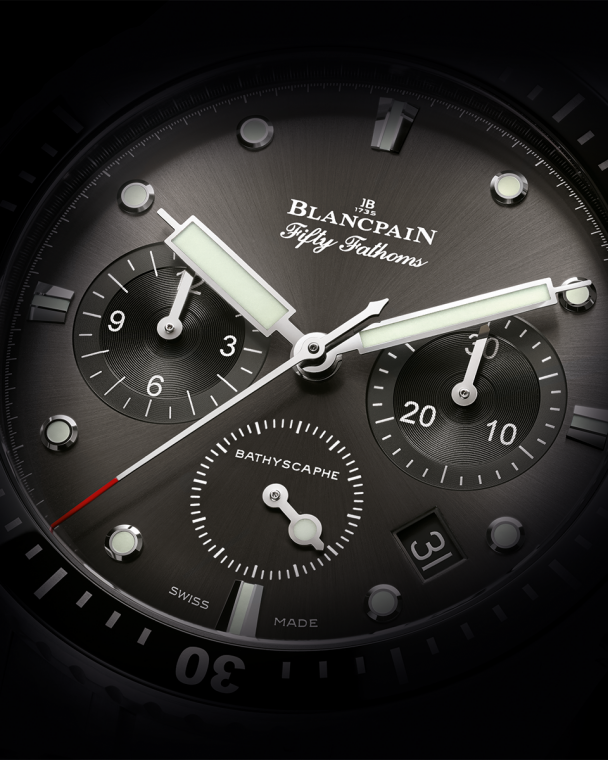
Other issues
Don't miss the latest issue
Sign Up for New Releases

